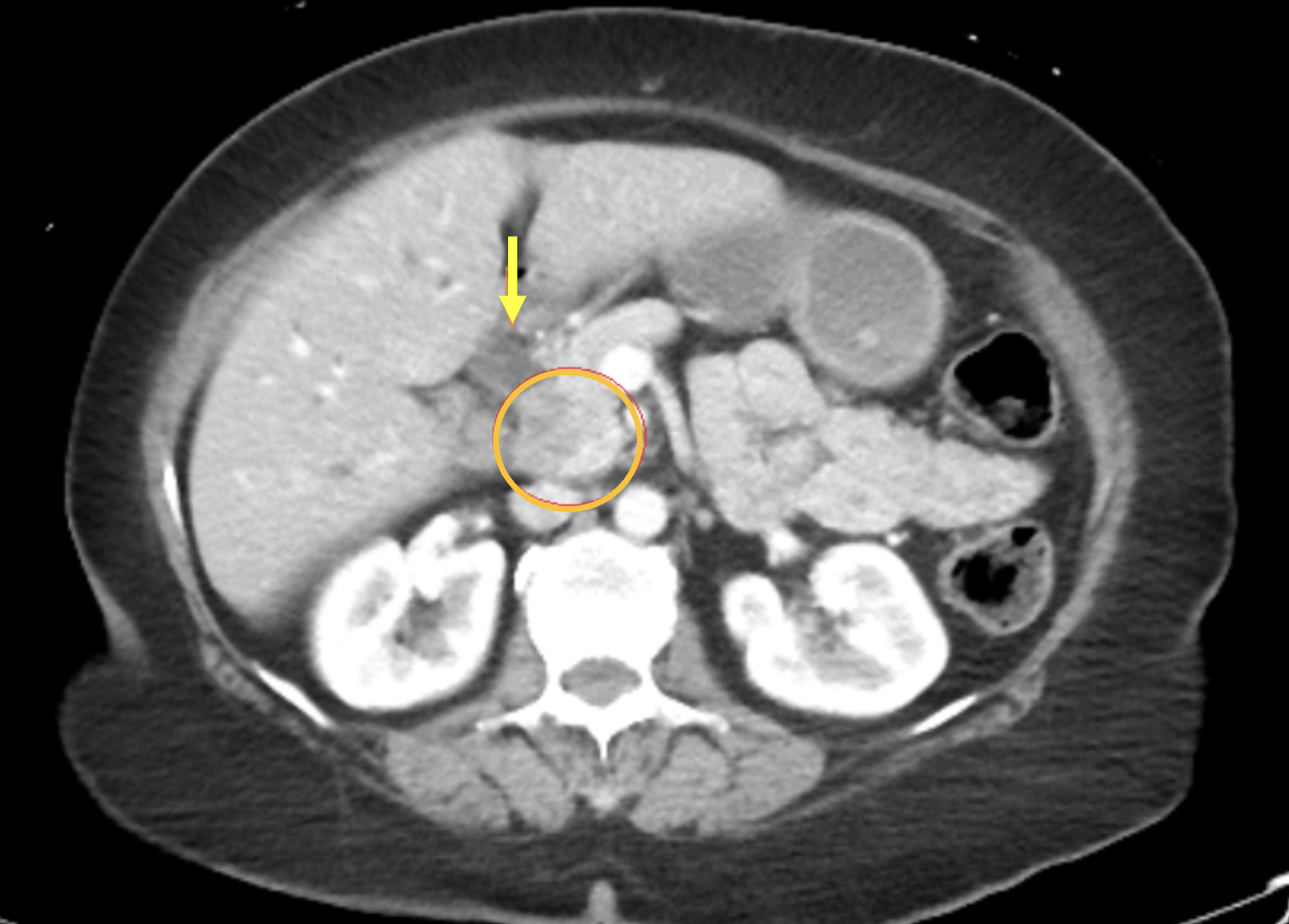Tuesday Poster Session
Category: Biliary/Pancreas
P4513 - Stenting Smarter: Recognizing Pancreatic Lymphoma During Endoscopy
Tuesday, October 28, 2025
10:30 AM - 4:00 PM PDT
Location: Exhibit Hall

Yannis S. Lafazanos, DO (he/him/his)
Advocate Lutheran General
Long Grove, IL
Presenting Author(s)
Yannis S. Lafazanos, DO1, Sufyan AbdulMujeeb, DO2, Asif Lakha, MD3, Nahren Asado, MD3, Eli Ehrenpreis, MD, FACG2
1Advocate Lutheran General, Long Grove, IL; 2Advocate Lutheran General, Park Ridge, IL; 3Advocate Lutheran General Hospital, Park Ridge, IL
Introduction: Primary pancreatic lymphoma is an exceptionally rare clinical entity, comprising only 0.2% of primary pancreatic tumors and fewer than 0.5% of all malignant lymphomas. Due to its predilection for the pancreatic head, it frequently presents with obstructive jaundice and mimics pancreatic adenocarcinoma on imaging, often leading to initial misdiagnosis. This diagnostic overlap has crucial implications for management, particularly for advanced endoscopists involved in biliary decompression via ERCP.
Case Description/
Methods: Our patient is a 63-year-old woman who presented with elevated bilirubin and liver enzymes on outpatient labwork. Her examination revealed painless jaundice and generalized pruritis. CT imaging of her abdomen showed a pancreatic head mass, suspicious for pancreatic adenocarcinoma (Figure 1). GI was consulted and she was taken for EUS with FNA of the pancreatic head mass, with rapid pathology concerning for diffuse large B-cell lymphoma (Figure 2). Given the findings, ERCP was performed during the same session, with placement of a plastic stent in the common bile duct for alleviation of obstructive cholestasis. She responded rapidly to corticosteroids and chemotherapy, with improvement of both symptoms and liver tests.
Discussion: This case underscores the critical need for endoscopists to distinguish pancreatic lymphoma from adenocarcinoma early in the diagnostic process. Unlike adenocarcinoma, which typically requires longer-term stenting with fully covered self-expanding metal stents due to persistent external compression, pancreatic lymphoma often regresses quickly with chemotherapy. Thus, plastic stents are preferred in suspected or confirmed lymphoma cases, as they are easier to remove, pose a lower risk of migration, and are appropriate for the typically short duration of biliary obstruction in responsive lymphoma cases. Early recognition and tailored stent selection can prevent unnecessary complications and align the endoscopic approach with the expected disease trajectory.
For advanced endoscopists, this case reinforces the importance of integrating pathologic diagnosis into procedural planning, especially when FNA suggests lymphoma. Plastic stent placement should be the default strategy in such scenarios, ensuring appropriate, flexible, and safe management of biliary obstruction in this rare but distinct malignancy.

Figure: Figure 1. CT of the Abdomen and Pelvis. Noted pancreatic head mass (orange circle), concerning for pancreatic adenocarcinoma on initial read, that is productive of dilated bile duct (yellow arrow). Other reported findings include focal narrowing of the proximal portal vein, which is suspicious of invasion.

Figure: Figure 2. Pathology. (A) A cell block of pancreatic mass shows diffuse sheet of neoplastic cells with extensive necrosis (H&E at 10x magnification). (B) Slide with CD20 immunohistochemical staining, the neoplastic cells have strong diffuse positive B-cell marker staining (at 20x magnification). (C) Slide with CD10 immunohistochemical staining, showing atypical B lymphoid cells with germinal center B-cell phenotype (at 40x magnification).
Disclosures:
Yannis Lafazanos indicated no relevant financial relationships.
Sufyan AbdulMujeeb indicated no relevant financial relationships.
Asif Lakha indicated no relevant financial relationships.
Nahren Asado indicated no relevant financial relationships.
Eli Ehrenpreis: E2Bio Consultants – Intellectual Property/Patents, CEO, Owner/Ownership Interest. E2Bio Life Sciences – CEO, Owner/Ownership Interest.
Yannis S. Lafazanos, DO1, Sufyan AbdulMujeeb, DO2, Asif Lakha, MD3, Nahren Asado, MD3, Eli Ehrenpreis, MD, FACG2. P4513 - Stenting Smarter: Recognizing Pancreatic Lymphoma During Endoscopy, ACG 2025 Annual Scientific Meeting Abstracts. Phoenix, AZ: American College of Gastroenterology.
1Advocate Lutheran General, Long Grove, IL; 2Advocate Lutheran General, Park Ridge, IL; 3Advocate Lutheran General Hospital, Park Ridge, IL
Introduction: Primary pancreatic lymphoma is an exceptionally rare clinical entity, comprising only 0.2% of primary pancreatic tumors and fewer than 0.5% of all malignant lymphomas. Due to its predilection for the pancreatic head, it frequently presents with obstructive jaundice and mimics pancreatic adenocarcinoma on imaging, often leading to initial misdiagnosis. This diagnostic overlap has crucial implications for management, particularly for advanced endoscopists involved in biliary decompression via ERCP.
Case Description/
Methods: Our patient is a 63-year-old woman who presented with elevated bilirubin and liver enzymes on outpatient labwork. Her examination revealed painless jaundice and generalized pruritis. CT imaging of her abdomen showed a pancreatic head mass, suspicious for pancreatic adenocarcinoma (Figure 1). GI was consulted and she was taken for EUS with FNA of the pancreatic head mass, with rapid pathology concerning for diffuse large B-cell lymphoma (Figure 2). Given the findings, ERCP was performed during the same session, with placement of a plastic stent in the common bile duct for alleviation of obstructive cholestasis. She responded rapidly to corticosteroids and chemotherapy, with improvement of both symptoms and liver tests.
Discussion: This case underscores the critical need for endoscopists to distinguish pancreatic lymphoma from adenocarcinoma early in the diagnostic process. Unlike adenocarcinoma, which typically requires longer-term stenting with fully covered self-expanding metal stents due to persistent external compression, pancreatic lymphoma often regresses quickly with chemotherapy. Thus, plastic stents are preferred in suspected or confirmed lymphoma cases, as they are easier to remove, pose a lower risk of migration, and are appropriate for the typically short duration of biliary obstruction in responsive lymphoma cases. Early recognition and tailored stent selection can prevent unnecessary complications and align the endoscopic approach with the expected disease trajectory.
For advanced endoscopists, this case reinforces the importance of integrating pathologic diagnosis into procedural planning, especially when FNA suggests lymphoma. Plastic stent placement should be the default strategy in such scenarios, ensuring appropriate, flexible, and safe management of biliary obstruction in this rare but distinct malignancy.

Figure: Figure 1. CT of the Abdomen and Pelvis. Noted pancreatic head mass (orange circle), concerning for pancreatic adenocarcinoma on initial read, that is productive of dilated bile duct (yellow arrow). Other reported findings include focal narrowing of the proximal portal vein, which is suspicious of invasion.

Figure: Figure 2. Pathology. (A) A cell block of pancreatic mass shows diffuse sheet of neoplastic cells with extensive necrosis (H&E at 10x magnification). (B) Slide with CD20 immunohistochemical staining, the neoplastic cells have strong diffuse positive B-cell marker staining (at 20x magnification). (C) Slide with CD10 immunohistochemical staining, showing atypical B lymphoid cells with germinal center B-cell phenotype (at 40x magnification).
Disclosures:
Yannis Lafazanos indicated no relevant financial relationships.
Sufyan AbdulMujeeb indicated no relevant financial relationships.
Asif Lakha indicated no relevant financial relationships.
Nahren Asado indicated no relevant financial relationships.
Eli Ehrenpreis: E2Bio Consultants – Intellectual Property/Patents, CEO, Owner/Ownership Interest. E2Bio Life Sciences – CEO, Owner/Ownership Interest.
Yannis S. Lafazanos, DO1, Sufyan AbdulMujeeb, DO2, Asif Lakha, MD3, Nahren Asado, MD3, Eli Ehrenpreis, MD, FACG2. P4513 - Stenting Smarter: Recognizing Pancreatic Lymphoma During Endoscopy, ACG 2025 Annual Scientific Meeting Abstracts. Phoenix, AZ: American College of Gastroenterology.
